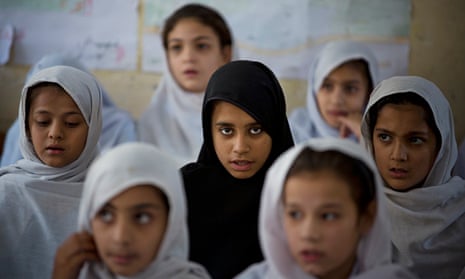They are all Malala. Four defiant, courageous girls who stand toe-to-toe with the education campaigner Malala Yousafzai. Four ordinary girls who have done extraordinary things representing thousands of Malalas across this dark and dangerous world.
And their cause – empowerment for girls – is the theme of a critical Oslo conference on education and development today, convened by the Norwegian prime minister, Erna Solberg, which Malala and I will address.
Malala was shot by Taliban gunmen for wanting to go to school and survived a bullet to the head. The four girls’ stories are different to Malala’s, but the bravery of each one of them is just as astonishing, and they all want the same outcome.
Like Malala, Geeta, Ashwini, Dilan and Razia have been fighting daily personal battles against those who would deny them education and condemn them to lives of child labour, child marriage or child trafficking.
They are waging the civil rights struggle of our time: a demand to end prejudice, discrimination and exclusion; and for ours to be the first generation in history to guarantee every single girl basic rights.
Geeta, from Nepal, was nine years old when she was sold into the sex trade and trafficked to India. To secure clients Geeta would wear makeup and be on the streets soliciting until 2am. She says she was forced to be with as many as 60 men each day. But out of a deep family tragedy is built a personal triumph. Rescued at the age of 14, she is now leading the way along with organisations such as the American Himalayan Foundation, who are trying to stop thousands of girls, including many made homeless from Nepal’s earthquake, being sold for $500 each into India.
At the age of 10, Dilan became part of what is now a mass exodus from Syria, fleeing with her mother in the dead of night into Lebanon – but it was a journey that took her from a school classroom to child labour. She spent her 11th birthday toiling in a garlic factory, peeling cloves and not earning a wage, only the right to a roof over her and her mother’s heads. Now, at 13, she wants to get back to school, become a teacher and one day help rebuild Syria. She is one of 1,000 global youth ambassadors for education, and is campaigning for 500,000 Syrian refugees to attend Lebanese schools.
Razia, who grew up in a village on the outskirts of Meerut, India, was sent to work at the age of four, stitching together small pieces of hide to make footballs. “My fingers bled whenever the needle pierced through them,” she recalls. “It happened with many children and some of them have suffered severe deformity. We had no idea that football players and businessmen made millions of dollars whereas we were trapped in a vicious circle of hunger and servitude.”
Rescued by the Nobel peace prize winner Kailash Satyarthi, she then pursued her education, became a young leader in the Global March Against Child Labour network, and when I met her was establishing the Nepalese national commission on child labour.
Ashwini was born blind and brought up in a poor rural community in India where bigoted neighbours tormented and mocked her for being disabled. One day, she decided to fight the discrimination and not only got the school grades that took her to college but has now become India’s premier champion of disabled rights, opening a residential school for visually impaired children.
These everyday stories of courage are repeated thousands of times over in girl-led movements such as the Nilphamari child marriage free zone in Bangladesh, Nepal’s Common Forum for Kalmal Hari Freedom, Indonesia’s Grobogan Child Empowerment Group and the Upper Manya Krobo Rights of the Child Club.
And there is good reason why this civil rights struggle is being stepped up now. Out-of-school numbers are rising fast because of the greatest exodus we have seen since 1945: a staggering 30 million displaced children on the long march from their homes into exile, often outside their own country in refugee camps, tents and hovels, offering little chance of ever going near a classroom.
After two decades during which 40 million more children enrolled for school, progress towards universal education has not only stalled but has gone into reverse with, as confirmed by Unesco figures today, 124m children out of school, 59m of them primary age, and the majority of them girls who have never enrolled.
The new set of statistics is damning. A look at primary and lower secondary ages combined shows one out of eight girls was out of school in 2013, and one out of nine boys. But the most tragic figures of all are that 24 million children will never enter a classroom. Half of all out-of-school children in sub-Saharan Africa will never enrol. And girls are the most disadvantaged, particularly in south and west Asia, where 80% of out-of-school girls are unlikely to start school, compared to just 16% for boys.
The UN’s new sustainable development goals call for secondary education for all by 2030; but to meet the additional costs and bridge the annual funding gap of $25bn for the poorest countries, we need innovative thinking.
This will start today in Oslo, when we consider creating the first humanitarian fund for education in emergencies. With its creation we can guarantee rapid action to help Syrian, Iraqi, South Sudanese and other girl refugees and intervene in places such as Nepal when catastrophe hits.

